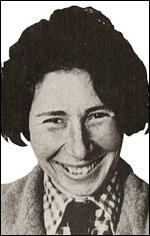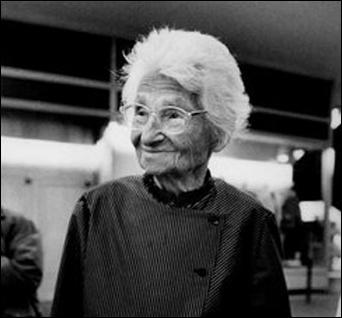Ursula Beurton

Ursula Kuczynski (also known as Ursula Beurton) was born in Schöneberg, Germany, on 15th May, 1907. She joined the German Communist Party in 1926. She decided to move to the United States in 1928. Ursula married Rudolf Hamburger and they both became Soviet spies. (1) Later she moved to China, where she became part of a spy ring under the direction of Richard Sorge.
In 1939 she moved to Britain and married Len Beurton. Posing as a Jewish refugee from Nazi Germany she established a Soviet spy-ring (codenamed SONYA) and by 1941 she was running a string of agents that included Klaus Fuchs from a base in Oxford. (2) The historian, Brian Sperrin, has put forward several reasons for this: “At the time her parents were living with friends in Oxford, because of the air raids in London. Oxfordshire was also close to her couriers and contacts in the capital. And it may also have been because of the closeness of nuclear research centres and the headquarters of MI5, which, because of the bombing raids in London, had moved a high proportion of its operation to Blenheim Palace.” (3)
According to a document in the NKVD archives, Fuchs began spying for the Soviet Union in August 1941: "Klaus Fuchs has been our source since August 1941, when he was recruited through the recommendation of Urgen Kuchinsky (an exiled German Communist resident in Great Britain). In connection with the laboratory's transfer to America, Fuchs's departure is expected, too. I should inform you that measures to organize a liaison with Fuchs in America have been taken by us, and more detailed data will be conveyed in the course of passing Fuchs to you." (4)
Ursula Beurton - Soviet Spy
Ursula Beurton later recalled: "Klaus and I never spent more than half an hour together when we met. Two minutes would have been enough but, apart from the pleasure of the meeting, it would arouse less suspicion if we took a little walk together rather than parting immediately. Nobody who did not live in such isolation can guess how precious these meetings with another German comrade were." (5)
Another member of the network was Melita Norwood. During the Second World War Norwood's work with British Non-Ferrous Metals Research Association (BN-FMRA) made her an important spy. In 1943 she began working for the director of BN-FMRA, G. L. Bailey, who was a member of the advisory committee of Tube Alloys, Britain's atomic bomb project. In March 1945, after BN-FMRA won a contract from Tube Alloys, Norwood gained access to documents that Moscow Centre described as being "of great interest and a valuable contribution to the development of the work in this field." It has been claimed by David Burke that "the information she supplied on the behaviour of uranium metal at high temperatures permitted the Soviet Union to test an atomic bomb four years earlier than British and American intelligence thought possible". (4) Christopher Andrew has claimed that Norwood was "both the most important British female agent in KGB history and the longest serving of all Soviet spies in Britain." (6) The KGB recorded that Norwood was a "committed, reliable and disciplined agent, striving to be of the utmost assistance." (7)
Arrest of Klaus Fuchs
Ursula Beurton was visited by MI5 twice in 1947 and had been questioned about her links with Soviet intelligence. "According to Ursula, she had refused to discuss the matter and the officials had showed no interest in Fuchs." Fearing that she was about to be arrested she now fled to East Germany. (8) Klaus Fuchs was not arrested until 1950. He made a full confession but by this time Beurton was safely behind the Iron Curtain. Although she resigned as a Soviet agent she worked for the East German government for the next ten years. She was awarded the Order of the Red Banner in 1969.

In 1987, Peter Wright, a MI5 officer, published his book, Spycatcher (1987). He claimed that another agent run by Ursula Beurton was "Elli". This is a Soviet agent that has never been identified. Wright is convinced that "Elli" was a senior figure in MI5 and was the man who tipped off Kim Philby in 1963. Wright and Arthur Martin, head of the Soviet counter-espionage section, spent a great deal listening to the confession that Philby had made to Nicholas Elliott. Wright later argued that Elli was either Roger Hollis, Director General of MI5 or his deputy, Graham Mitchell : "There was no doubt in anyone's mind, listening to the tape, that Philby arrived at the safe house well prepared for Elliott's confrontation. Elliott told him there was new evidence, that he was now convinced of his guilt, and Philby, who had denied everything time and again for a decade, swiftly admitted spying since 1934. He never once asked what the new evidence was." Both men came to the conclusion that Philby had not asked about the new evidence as he had already been told about it. This convinced them that the "Russians still had access to a source inside British Intelligence who was monitoring the progress of the Philby case. Only a handful of officers had such access, chief among them being Hollis and Mitchell." (9)
Ursula Beurton died in Berlin on 7th July, 2000.
Primary Sources
(1) Nigel West, The Crown Jewels: The British Secrets Exposed by the KGB Archives (1999)
Although Fuchs confessed at his trial that he had worked for Soviet Intelligence, the Centre wanted to find out how MI5 had traced him, and accordingly meetings were arranged with everyone who could be reached who at any time had participated in his secret life, or had been aware of it. The list was not very long: Jurgen Kuczinsky and his sister Ursula Beurton, Hanna Klopstock and Hans Zibert. Of these only Ursula Beurton, the GRU illegal who had been connected with Fuchs between 1942 and 1943, had left for East Germany after his arrest; she told an MGB official that she had been visited twice in 1947 by MI5, and had been questioned about her former links with Soviet Intelligence. According to Ursula, she had refused to discuss the matter and the officials had showed no interest in Fuchs. As for Fuchs's behaviour under MI5's interrogation, Ursula was of the opinion that "from a political point of view he turned out to be weak ... his confession was not the result of malice, but of political immaturity." In her view, the Fuchs investigation could have started after the explosion of the Soviet atom bomb, when a search for Communists might have led to him. Ursula's opinion was quite reasonable, but too vague to satisfy the Centre which was anxious to learn precisely what had happened.
(2) Debbie Waite, Oxford Mail (6th August, 2010)
The ability to blends into ones’ surroundings is vital for successful spies – and was something one of the Soviet Union’s most successful agents – Ruth Werner, aka Ursula Beurton, codename Sonya – managed for several years in Oxfordshire in the 1940s.
Born Ursula Ruth Kuczynski, in 1907, into a Polish Jewish family in Berlin, she joined the German Communist Party at 19 and in her early 20s was recruited by the GRU, the Soviet Union’s military intelligence service.
After marrying, she accompanied her architect husband Rudolf Hamburger to China in 1930, where he worked in Shanghai.
After returning to Europe, the GRU sent her to their Moscow training centre, where she was taught codes and how to build and operate radio receivers, before going on assignments in Poland and Switzerland.
After divorcing, she married Briton Leonard Beurton, who was also a Soviet agent.
In January 1941 she embarked on her most dangerous mission – travelling to Liverpool, then on to Oxford, to start a double life as a housewife and spy.
It’s not clear why she chose Oxford as a base, but historian and former Kidlington resident, Brian Sperrin, has a number of suggestions for the decision.
He said: “At the time her parents were living with friends in Oxford, because of the air raids in London. Oxfordshire was also close to her couriers and contacts in the capital.
“And it may also have been because of the closeness of nuclear research centres and the headquarters of MI5, which, because of the bombing raids in London, had moved a high proportion of its operation to Blenheim Palace.”
